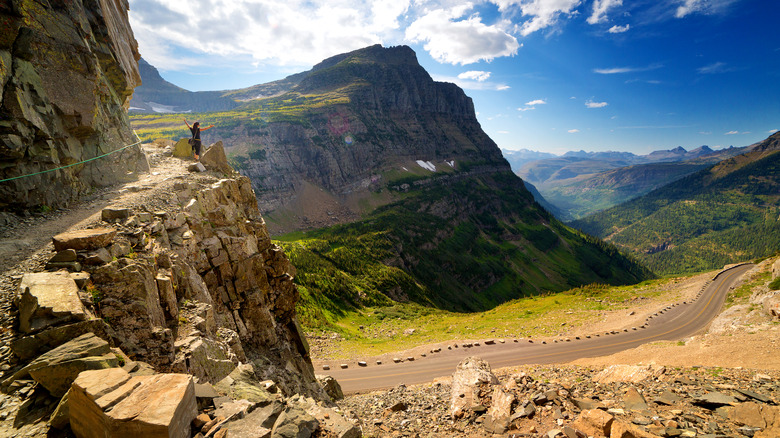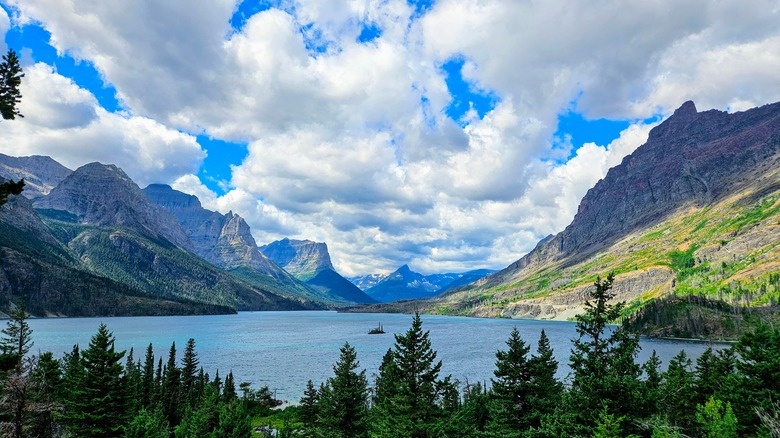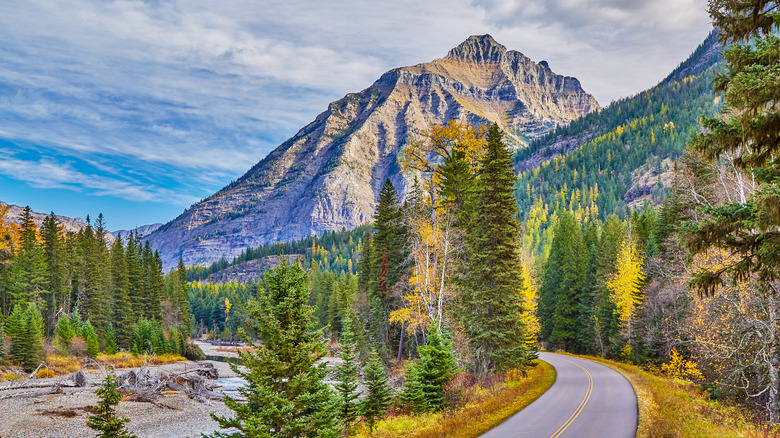One Of America's Most Scenic Roads Is A Mountainous Highway Through Glacier National Park
Glacier National Park in Montana has been called the Crown of the Continent, thanks to the natural beauty of its towering peaks, green forests, and incredible glaciers. So it makes sense that one of America's most beautiful roads is the one running through this national park. The Going-to-the-Sun Road is around 50 miles and takes you between the east and west sides of the park and up and over the Continental Divide at Logan Pass.
The road got its moniker from the nearby mountain of the same name, and it is quite the engineering marvel that takes you through some challenging terrain. The construction of the road started around a decade after Glacier National Park was formed in 1910, and it was completed in 1933. It wasn't paved, however, until the early 1950s.
You can drive the Going-to-the-Sun Road in either direction with the west entrance as the most popular starting point. But if you (or someone you're with) gets anxious with sheer drop-offs, you might want to go from east to west so you're not right next to the edge the entire time. Or you can leave the driving to someone else and take a guided tour.
While you could drive the whole thing in a few hours, if you can, give yourself the whole day (if not more) to traverse this mountain road so you can take your time stopping to appreciate the stunning scenery and panoramic overlooks. If you're planning on doing much hiking or exploring beyond the drive, give yourself a couple of days, pack your camping gear, and look into spending the night in one of the five campgrounds along the road.
Stop to see lakes, waterfalls, and more along the Going-to-the-Sun Road
It's impossible to include everything you can see and do along the Going-to-the-Sun Road, but some highlights are the alpine lakes, waterfalls, and historic structures. Lakes basically bookend the drive. Near the west entrance, the road runs along the 10-mile-long Lake McDonald, where you can go fishing, kayaking, and hiking. Nearby is the Lake McDonald Lodge. Even if you're not staying in one of its rustic rooms or cabins, it's worth checking out. Originally built in 1913, it has a Swiss chalet vibe, which will make you feel like you're in Europe without leaving the U.S. On the east side of the drive is St. Mary Lake, where you might spot wildlife like elk and bears. The lake has a tiny island in it, which you can see from the much-frequented Wild Goose Island Overlook.
You're spoiled for choice when it comes to waterfalls, whether you want to see them from a roadside pullout or you want to go on a hike. For some closer to the road, McDonald Creek has McDonald Falls and Sacred Dancing Cascade; Bird Woman Falls is a 492-foot-tall waterfall between Mount Oberlin and Mount Cannon; and the Weeping Wall is literally right along the road. Waterfalls you can hike to include St. Mary Falls, Virginia Falls, and Baring Falls, and you can see all three of them on the 5.6-mile-long Three Falls Trail.
The best place to see a glacier from the road is at the Jackson Glacier Overlook between Logan Pass and St. Mary. And Logan Pass, at 6,646 feet, is a famed spot literally at the top of the road. The parking lot here is often crowded, so get there as early as you can.
Some things to keep in mind when driving Going-to-the-Sun Road in Glacier National Park
There's a 1-mile section of the Going-to-the-Sun road on the east side of Logan Pass that can be covered in anywhere from 50 to 80 feet of snow in the winter. You read that right — feet! There's even a nickname for the massive snow that has to be plowed off the road each spring — the "Big Drift." It's quite the feat to remove all that snow, so each year's official opening date is unique. Broadly speaking, though, you can likely drive the Going-to-the-Sun Road in its entirety between late June/early July and mid to late October, but check the park's road status website for the most up-to-date info.
Given the area's beauty and its increasing popularity, reservations are required to drive the road during peak times: starting on May 24 for west side traffic and on July 1 for the east side. September 8 is the last day reservations are required for both sides. No reservation is needed if you get on the road before 6 a.m. or after 3 p.m., but you will still need a national park pass. Your vehicle can't be longer than 21 feet or wider than 8 feet.
There are three visitor centers, one at each end and then one at Logan Pass. They're great places to stop for water and a bathroom break, but there aren't any other services once you get into the center of the park — so make sure you've got all the supplies you need.


